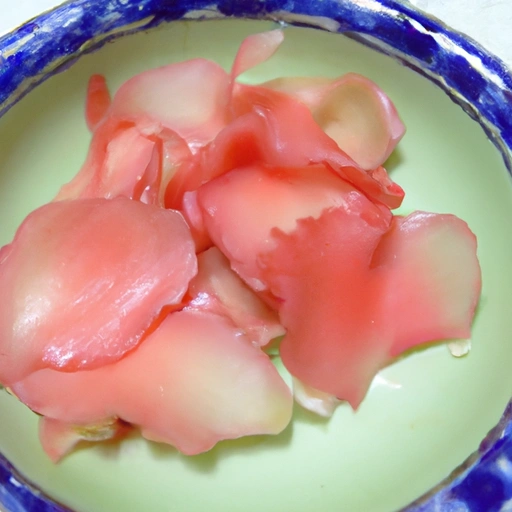Pickled Ginger
Description

Pickled ginger, also known as 'gari' or 'beni shoga' in Japanese, is a type of tsukemono (Japanese pickled vegetables). It's made from thinly sliced young ginger that has been marinated in a solution of vinegar and sugar, often with a touch of salt. The pickling process turns the ginger a natural pink hue, although some manufacturers may add artificial coloring to enhance its appearance. With its sweet, tangy, and slightly spicy taste, pickled ginger cleanses the palate and is commonly utilized in both Asian and Western cuisines.
Common uses
Pickled ginger is widely used as a palate cleanser, garnish, and flavor enhancer. It's often found accompanying sushi and sashimi but also adds a zesty kick to salads, marinades, and sandwiches. Its versatile nature makes it a favorite ingredient for chefs looking to add a touch of brightness and acidity to their dishes.
Nutritional value
Calories
Typically, a one-ounce (28 grams) serving of pickled ginger contains approximately 20 calories.
Protein
Pickled ginger is low in protein, with a one-ounce (28 grams) serving offering less than 1 gram of protein.
Fat
There is negligible fat content in pickled ginger, making it a fat-free addition to meals.
Carbohydrates
Carbohydrates are present in moderate amounts, with a one-ounce (28 grams) serving containing around 5 grams, largely from sugars used in the pickling process.
Vitamins
Pickled ginger contains small amounts of vitamins, particularly vitamin C, although the amounts can vary depending on the preparation method.
Minerals
Minerals such as potassium can be found in pickled ginger, contributing to its health benefits.
Health benefits
Pickled ginger is believed to offer several health benefits, including aiding digestion, reducing nausea, and possessing anti-inflammatory properties. It is also thought to help boost the immune system due to the presence of gingerol, an active compound found in ginger.
Potential risks
While pickled ginger is generally safe for consumption, overindulgence may lead to gastrointestinal discomfort. Individuals with a sensitivity to vinegar or those watching their sodium intake should consume it in moderation. Additionally, the pink coloring in some commercially prepared pickled ginger may come from artificial dyes, which some consumers may wish to avoid.
Common recipes
Pickled ginger is a key ingredient in many sushi and sashimi recipes and is often used to make sauces and dressings. It is also incorporated into poke bowls, Asian salads, and can even be enjoyed on its own as a snack.
Cooking methods
The most common method of preparing pickled ginger is through a quick pickling process, which preserves the ginger's crisp texture while imparting a tangy flavor.
Pairing with other ingredients
Its refreshing taste pairs well with rich and fatty foods, such as grilled meats and creamy cheeses, as well as with other pickled vegetables and aromatic herbs.
Summary
Pickled ginger is a globally beloved condiment known for its unique flavor profile and ability to enhance a variety of dishes. Whether used as a palate cleanser with sushi or as an ingredient in creative culinary creations, it brings a delightful zing and a host of potential health benefits. With its low calorie and fat content, it's a health-conscious choice that adds excitement to meals without guilt.